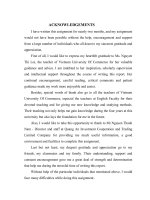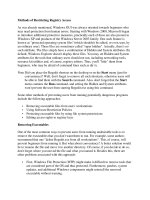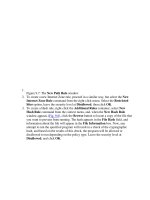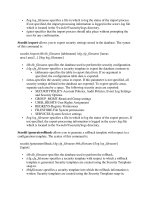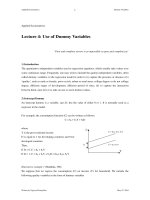Lecture no49 methods of financing
Bạn đang xem bản rút gọn của tài liệu. Xem và tải ngay bản đầy đủ của tài liệu tại đây (334.72 KB, 12 trang )
Methods of Financing
Lecture No. 49
Chapter 15
Contemporary Engineering Economics
Copyright © 2016
th
Contemporary Engineering Economics, 6 edition
Park
Copyright © 2016 by Pearson Education, Inc.
All Rights Reserved
Chapter Opening Story
Laredo Petroleum Holdings has approved a
$1 billion capital budget for 2014, which will
be funded from internally generated cash
flow and borrowings from senior securities.
At issue: Because of the size of financing
involved, the firm financing method will
affect the firm’s capital structure, the
cost of capital, and financial risk.
th
Contemporary Engineering Economics, 6 edition
Park
Copyright © 2016 by Pearson Education, Inc.
All Rights Reserved
Methods of Financing
o
Equity Financing
o
Debt Financing
o
Capital Structure
o
Capital is coming from either retained earnings or funds raised from an issuance of stock.
o
Money raised through loans or by an issuance of bonds.
o
Well managed firms establish a target capital structure and strive to maintain the debt ratio.
th
Contemporary Engineering Economics, 6 edition
Park
Copyright © 2016 by Pearson Education, Inc.
All Rights Reserved
Equity Financing
•
Flotation (discount) costs
–
The expenses associated with issuing new
securities
•
Types of equity financing
o
o
o
Retained earnings
Common stock
Preferred stock
th
Contemporary Engineering Economics, 6 edition
Park
Copyright © 2016 by Pearson Education, Inc.
All Rights Reserved
Example 15.1: Equity Financing by Issuing Common Stock
Given:
o Scientific Sports, Inc. (SSI) needs to finance $10 million to develop and produce a new
metal golf driver.
o Share price for the new stock offering = $28
o Floatation cost = 6% of the issue price
Find: How many shares must SSI sell to net $10 million?
th
Contemporary Engineering Economics, 6 edition
Park
Copyright © 2016 by Pearson Education, Inc.
All Rights Reserved
Solution
o (0.06)($28)(X) = 1.68X
o
Sales proceeds − flotation cost = Net
proceeds
28X − 1.68X =$10,000,000
26.32X = $10,000,000
X = 379,940 shares.
1.68(379,940) = $638,300
th
Contemporary Engineering Economics, 6 edition
Park
Copyright © 2016 by Pearson Education, Inc.
All Rights Reserved
Debt Financing
•
•
Bond Financing:
o May incur floatation cost
o No partial payment of principal
o Only interest is paid each year (or semiannually).
o The principal (face value) is paid in a
lump sum when the bond matures.
Term Loan:
o May involve an equal repayment
arrangement
o May incur origination fee
o Terms negotiated directly between
the borrowing company and a
financial institution
th
Contemporary Engineering Economics, 6 edition
Park
Copyright © 2016 by Pearson Education, Inc.
All Rights Reserved
Example 15.2: Debt Financing by Issuing Bonds
Given: Scientific Sports, Inc. (SSI) needs to finance $10 million by issuing a mortgage bond.
o
o
o
o
Face value = $1,000
Market price = $985
Coupon rate = 12% interest payable annually
Floatation cost = 1.8% of the issue price
Find: (a) Number of bonds to be sold to net $10 million? (b) the total annual interest
payment
th
Contemporary Engineering Economics, 6 edition
Park
Copyright © 2016 by Pearson Education, Inc.
All Rights Reserved
Solution
(a) To net $10 million, SSI would have to sell:
$10,000,000/(1 − 0.018) = $10,183,300 worth of bonds and pay $183,300 in flotation costs.
Since the $1,000 bond would be sold at $985, a 1.5% discount, the total number of bonds to
be sold would be:
$10,183,300/($985) = 10,339.
(b) For the bond financing, the annual interest is equal to:
$10,338,380 (0.12) = $1,240,606
Only the interest is paid each period, and thus the principal amount owed remains
unchanged.
th
Contemporary Engineering Economics, 6 edition
Park
Copyright © 2016 by Pearson Education, Inc.
All Rights Reserved
Capital Structure (Debt Ratio)
•
•
Definition: The means by which a firm is financed.
Mixed Financing: Capital is raised by borrowing from financial institutions and
by issuing stocks and/or using retained earnings.
•
Target Capital Structure: Set a target debt ratio by considering both business
risk and expected future earnings.
th
Contemporary Engineering Economics, 6 edition
Park
Copyright © 2016 by Pearson Education, Inc.
All Rights Reserved
Example 15.3: Project Financing Based on an Optimal Capital Structure
Given:
oSSI’s capital structure = 0.50
oRaise $5M by issuing
common stock and $5M by
issuing bonds at 12%
interest.
Floatation cost
Stock: 8.1%
Bond: 3.2%
o
•
•
Find: Project cash flows
th
Contemporary Engineering Economics, 6 edition
Park
oProject Description
•Life: 5 years
•Building: $3M
•Equipment: $6M
•Land: $1M
•Cash dividend: $2 per share
•Unit production cost: $50.31
•Unit price: $250
•Annual O&M cost: $600,000
•Annual demand: 20,000 units
•Working capital: $500,000
•Tax rate: 40%
Copyright © 2016 by Pearson Education, Inc.
All Rights Reserved
Solution
th
Contemporary Engineering Economics, 6 edition
Park
Copyright © 2016 by Pearson Education, Inc.
All Rights Reserved



